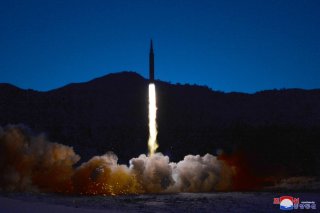The Pentagon's Big Bet: Billion Dollar Budgets for Hypersonic Missile Defense
The Missile Defense Agency believes hypersonic missile defense is achievable.
Here's What to Remember: This emphasis on prioritizing R&D is entirely consistent with the Pentagon's effort to confront the current challenges facing missile defense.
The Missile Defense Agency is investing in a new kind of space sensor intended to track and ultimately stop hypersonic weapons traveling at more than five times the speed of sound, a modern weapon expected to greatly inform, if not change, paradigms for future warfare.
As part of its 2022 budget submission, the Missile Defense Agency has requested funds to deliver a “hypersonic and ballistic tracking space sensor,” intended to “provide fire control quality data to track dim ballistics threats and global maneuvering hypersonic threats,” Navy Vice Admiral Jon Hill, Director of the Missile Defense Agency (MDA), told reporters according to a Pentagon transcript.
The new sensor program, which the MDA is developing with the U.S. Space Force and Space Development Agency will deploy its first two satellites in 2023, Hill added. The new technology will ultimately replace the existing Space Tracking and Surveillance System, or STSS, which is now in orbit.
Interestingly, the emerging program is consistent with a broad emphasis throughout the MDA budget request, which is the massive amount of money being devoted to research and development. Of the entire $8.9 billion 2022 budget request, $7.2 billion, or eighty percent, is slated for research and development.
This emphasis on prioritizing R&D is entirely consistent with the Pentagon's effort to confront the current challenges facing missile defense. Not only are hypersonic weapons causing new problems for existing missile defense technologies, but lasers are approaching operational readiness for space and potential rivals are massively expanding their Intercontinental Ballistic Missile (ICBM) arsenals. As part of this threat equation, adversaries are likely to deploy newer kinds of advanced countermeasures, decoys, or anti-jam technologies intended to ensure an attacking ICBM is able to continue on to its intended target.
The budget request also includes requests for money to develop a regional hypersonic defense glide phase intercept capability, a kind of sensor-tracking system potentially analogous to what is being developed in space. Upon target approach, a hypersonic glide weapon uses its speed of descent to hit targets and destroy or overwhelm them before there is an opportunity to respond. Hill mentioned this intercept capability in coordination with mentioning funding defenses for Guam to support specific requests from the Pacific theater.
Advanced space-based sensing to track hypersonic weapons might represent one of just several areas of hope for Pentagon weapons developers confronting the challenge of how to attempt defending against hypersonic weapons. Guided missiles traveling at hypersonic speeds may simply be arriving so quickly that ground-based commanders will not be able to detect a threat in time to respond. Part of this challenge is compounded by the fact that a weapon traveling at hypersonic speeds will likely transit from one radar aperture to another so quickly, that coordinated radar systems may not be able to keep a consistent track on a target across different geographical reasons, something it is able to do with non-hypersonic weapons.
Detecting hypersonic weapons from space, however, at very rapid speeds, can greatly change the equation and increase the likelihood that defenders could establish a more continuous track of the approaching weapon sufficient to coordinate some defense or intercept.
Kris Osborn is the Defense Editor for the National Interest. Osborn previously served at the Pentagon as a Highly Qualified Expert with the Office of the Assistant Secretary of the Army—Acquisition, Logistics & Technology. Osborn has also worked as an anchor and on-air military specialist at national TV networks. He has appeared as a guest military expert on Fox News, MSNBC, The Military Channel, and The History Channel. He also has a Master's Degree in Comparative Literature from Columbia University.
This article is being republished due to reader interest.
Image: Air Force Mag.

